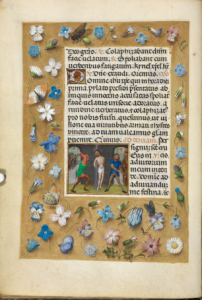School has officially ended, and finals are over; Spring semester will soon begin. Despite this, the Hargrett Passion project is still on my mind. So much has been accomplished this last semester, and there’s so much that we’re looking forward to doing in the Spring. Katie and I started off with the survey of manuscripts, and from there, we developed our own focus, public research presentations, and even more questions. It’s hard to believe that all of this has happened in one semester, and that it is already over.
The daunting task of surveying as many manuscripts from a handful of databases in order to have a decent sample size was a challenge at times. We were hoping to find more Passion related texts that matched those found in the Hargrett MS 836, but quite often, we would come up empty handed, only having our frustrations with the databases we were working on as a reward for the day. It certainly paid off, though. We catalogued 215 manuscripts, out of which thirty had the Long Hours of the Passion. I know that thirty out of 215 manuscripts seems like a tiny number, but compared to what I looked at in the Fall of 2016, this sample was huge.
One manuscript in particular was a sort of milestone for my research. The British Library Add MS 38126 contained the Long Hours of the Passion, but also related prayers, scripture, and a separate Psalter of the Passion.

It was a jackpot. I ended up using this manuscript in my 4’33” Spotlight on Scholarship in the Arts Poster competition. Comparing the contents of the Hargrett Hours Office of the Passion to the British Library manuscript, I was able to narrow my focus of how to look at the textual contents. Psalms and hymns were the meat of each hour in both of the Books of Hours, so they were the right place to start looking for standardization of the Passion texts.
In a sense, this poster project felt like a return to middle school for me. I competed in science fair for years, and even after that regularly helped my siblings with their projects. The basic contents and layout of a research poster were easy for me. The hard part was the actual presentation of my research at the judging. I’ve never really had a problem with public speaking, and even in middle school, I was never horribly nervous about explaining projects to judges. This poster, however, did make me nervous. I suppose that it’s the fact that I was presenting actual scholarly research that meant something to me and potentially to other people. The comparison of the Psalms and Hymns in each manuscript wasn’t just a random topic that I picked out with the help of my parents that I knew was doable — it was research that was personally important to me. It held meaning. Everything paid off though. I won the category for Clearest Presentation of Research, so that was incredibly satisfying.
The research that I presented in the poster was the source of a realization for me. Looking at a Latin/English parallel translation of Psalm 21, I noticed that the second verse was familiar. After some thought, I realized that it was because the same words were spoken by Christ before his death in several of the Gospels. I was amazed. Something like that had slipped by me without me noticing, and yet there I was wondering why certain Psalms were appearing in the Long Hours of the Passion. As I worked on cataloguing the Psalms in the Offices from the other manuscripts, I definitely noticed a pattern. Certain Psalms appeared more frequently, especially in specific hours. Already, data was pointing to at least this aspect of the Office being potentially standardized, or at least following a pattern. Further research done with a modern day study Bible led me to verses in the Gospel accounts of the Passion that were connected to many of these Psalms. There did seem to be a reason for the most common selections’ appearances! And based on my findings, the Hargret Hours actually features the same Psalms in Laudes/Prime through Vespers that I found occurred the most often in each liturgical hour. For example, Psalm 21 appeared most frequently in sext, and was the most common Psalm to be used in that hour. The Hargrett manuscript features that Psalm in sext.
So ultimately, I know that at least one aspect of the Office of the Passion might be standardized. I need to find more manuscripts with those Hours in them so that I can create an even larger sample in order to truly solidify that hypothesis, but right now it looks plausible. To fully understand the whole of the Long Hours of the Passion though, I need to do the same type of research on the hymns that appear in each manuscript. From there, I might be able to determine if there are common hymns for the Long Hours of the Passion, as well as for each individual hour. It’s exciting that the research has come so far since the class was originally trying to determine the contents of Hargrett MS 836, and realized that it had the Long Hours of the Passion, but not the Hours of the Virgin. I can only look forward to more this Spring.